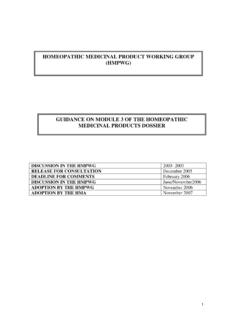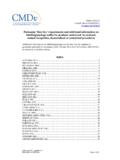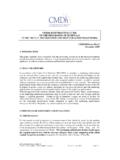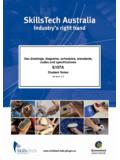Transcription of CMDv BPG-017 BEST PRACTICE GUIDE for the submission of ...
1 EMA/CMDv/68043/2013 7 November 2013 CMDv BPG-017 BEST PRACTICE GUIDE for the submission of high quality national translations for veterinary medicines Edition number : 00 Page 1 of 7 CMDv BEST PRACTICE GUIDE for the submission of high quality national translations for veterinary medicines CMDv/BPG/017 Ed.: 00 Page 2 of 7 TABLE OF CONTENTS 1. INTRODUCTION .. 3 2. AIM AND SCOPE .. 3 3. CRITERIA TAKEN IN ACCOUNT FOR LINGUISTIC REVIEW OF THE product information .. 4 4. PROCESS OF REVIEWING THE TRANSLATIONS .. 6 submission .. 6 National implementation .. 7 In case of non-acceptability.
2 7 EMA/CMDv/68043/2013 CMDv BEST PRACTICE GUIDE for the submission of high quality national translations for veterinary medicines CMDv/BPG/017 Ed.: 00 Page 3 of 7 1. INTRODUCTION New Applications: DCP and MRP The Best PRACTICE GUIDE for Veterinary Decentralised Procedure (DCP) and the Best PRACTICE GUIDE for Veterinary Mutual Recognition Procedures (MRP) of the Co-ordination Group for Mutual Recognition and Decentralised Procedures (CMDv) states that: the MAH should send the national translations within 5 days of the procedure ending. Variations The CMDv Best PRACTICE Guides for variations states that: for type IA, type IB and type II variations the MAH should send the national translations within 10 days of the procedure ending.
3 The applicant must submit high quality national translations of the product information ( product information = SPC + Labelling + PL), and mock-ups when required, in accordance with the timelines described in the Best PRACTICE Guides mentioned above. For DCP/MRP marketing authorisation applications the high quality national translations shall be submitted within 5 days after the end of the procedure. A product cannot be approved and placed on the market until high quality national translation(s) has been deemed acceptable by the NCA. MSs may only introduce linguistic changes to the product information and must ensure the national version of the product information is a faithful translation of the final harmonised position (this guidance document does not cover the blue box requirements for each MS).
4 The applicant should also be aware that translating does not equal a word-to-word translation from one language to another. It is therefore of crucial importance, that the translation is made by a person who has professional knowledge of the field and whose mother tongue should preferably be the target language (avoiding the use of machine translations). 2. AIM AND SCOPE This document aims to improve the quality of translations of the agreed product information submitted during the national implementation phase of the procedures. It provides information about criteria defined to ensure the high quality, clarity, consistency and coherence of the product information translations.
5 This document also intends to ensure and facilitate the compliance with the timelines by all parties involved to comply with the established legal timeframe for the national phase and to avoid delay in the market access of the veterinary medicinal products. This guidance should be read together with the: CMDv Best PRACTICE GUIDE for the Veterinary Decentralised Procedure CMDv Best PRACTICE GUIDE for the Veterinary Mutual Recognition Procedure CMDv Best PRACTICE GUIDE For Renewals CMDv Best PRACTICE GUIDE For Type IA Variations CMDv Best PRACTICE GUIDE For Type IB Variations EMA/CMDv/68043/2013 CMDv BEST PRACTICE GUIDE for the submission of high quality national translations for veterinary medicines CMDv/BPG/017 Ed.
6 : 00 Page 4 of 7 CMDv Best PRACTICE GUIDE For Type II Variations National guidance on language specific conditions There is a requirement for package leaflets to be written in terms, which the general public will find easy to understand. 3. CRITERIA TAKEN IN ACCOUNT FOR LINGUISTIC REVIEW OF THE product information In accordance with the guidance established in the CMDv Best PRACTICE Guides for Veterinary Medicinal Products (please see list above in section 1), the applicant must submit high quality translations of the final agreed versions of the product information .
7 To guarantee the quality of the product information translation, the applicant should check all crucial issues ensuring their compliance, namely a complete national translation with clear wording. Specific attention should be given to spelling, punctuation and other grammatical aspects taking also into account the extent of editorial and stylistic changes, particularly with the rephrasing of the texts ensuring that the meaning of the information is clear and comprehensible and in agreement with the final harmonised product information . A correct user friendly translation of the PL is just as important as a high quality medically correct translation of the SPC.
8 This will often not be achieved by a literal translation of the English text. The proposed product information should take into account the following points: a) Compliance of the translation with the final agreed product information The applicant must ensure a faithful translation of the final agreed product information approved at the end of the European phase of the procedure, avoiding omissions and/or addition of sentences, terms or paragraphs. b) Use of QRD vet template, country specific national language version The submitted translations must ensure that the latest approved QRDvet/CMDv veterinary template version and its appendixes are used.
9 Therefore, the applicant should not use different titles, subtitles and sentences from those stated on current QRDvet/CMDv veterinary template and its appendixes. The current QRDvet/CMDv veterinary template including implementation plans are available at the EMA QRD website and at the CMDv pages at HMAs website EMA/CMDv/68043/2013 CMDv BEST PRACTICE GUIDE for the submission of high quality national translations for veterinary medicines CMDv/BPG/017 Ed.: 00 Page 5 of 7 c) User-friendly terms for the Package Leaflet NEW New wording in the QRDvet/CMDv template [Version 8, 10/2012] The package leaflet must be easily readable for the healthcare professionals, farmers and animal owners.
10 The package leaflet should reflect the terminology the user is likely to be familiar with. References: Instructions preceding the leaflet section in the annotated template. Article 61 in Directive 2001/82/EC, amended by Directive 2004/28/EC. d) Tables of non-standard abbreviations Tables of non-standard abbreviations should be applied. Please refer to the EMA QRD website. e) Compilation of QRD decisions on stylistic matters in product information A compilation of QRD decisions on stylistic matters in product information should be adhered to. Please refer to the EMA QRD website.










